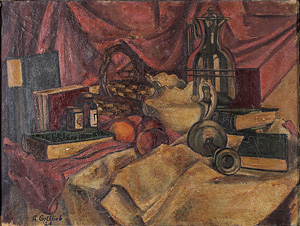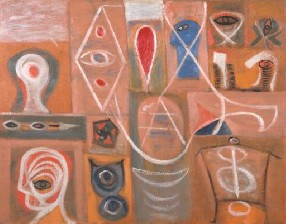Becoming Expressionism
John Haberin New York City
A Still Life by Adolph Gottlieb
I feel lucky to be able to talk about this artist and this painting. It is a very early but intriguing painting by a major painter, Adolph Gottlieb. When it comes to art, Abstract Expressionism was among my first true loves, and here one gets to ask how it came to be.
Starting early
Abstract Expressionism is still the textbook standard for American art's entering the modern stage, and Gottlieb worked and exhibited with the best of them. He appears in that 1951 Life magazine photo by Nina Leen of the "Irascible Group of Advanced Artists." The movement is also called the New York School, and Gottlieb along with Barnett Newman and Lee Krasner were its native New Yorkers. Well, Krasner was actually from Brooklyn before it was hip, but we forgive her.  Like her, Gottlieb was also Jewish. Like the immigrants in the group, they knew well what it meant to leave the turmoil of Europe behind.
Like her, Gottlieb was also Jewish. Like the immigrants in the group, they knew well what it meant to leave the turmoil of Europe behind.
You may know him from his signature work of the 1950s and after, until his death in 1974. Most Abstract Expressionists had a signature motif, like drips for Jackson Pollock or "zips," meaning vertical bars, for Newman. Gottlieb's was a vertical pairing, much as Mark Rothko often paired his floating rectangles. On top, against a field of bright white, sometimes scarred or stained with black and color, he placed a plainly geometric form. It might be a soft-edged circle filled with color or one or more tilted red crosses. Below, he placed a circle with much rougher edges, from paint smeared out in all directions.
John Ruskin, the nineteenth-century critic, famously accused James McNeill Whistler of flinging a pot of paint at the public. You could imagine that bottom field as a single splash of paint, although of course that is only an illusion. The outward marks are individual brushstrokes. You could also imagine the top form as something more impersonal, a mere symbol. Yet it, too, emerged from the artist's head and hand. Together, they appear as an explosion on canvas.
You may also know Adolph Gottlieb from work in the preceding decade, for which he coined the label pictographs in 1941. They are transitional work, much as Jackson Pollock had to work his way through Surrealism. They consist of stick figures or totems arranged in columns on a field of darker color. People often associate them with "primitivism" or the supposed universals of Carl Jung. Maybe, although Gottlieb was making art for today. No question, though, but he was learning to look within.
Here we have an early work, from 1924. To give you an idea of just how early, Pollock was then twelve years old. Gottlieb, who was twenty or twenty-one, had taken classes at Parsons and the Art Students League. Hans Hofmann, the Abstract Expressionist and mentor to others, was not there yet, for he had not left Europe (and, after that, Berkeley). Rather, Gottlieb studied with such leading lights of early American Modernism as John Sloan and Robert Henri. Their realism can seem stodgy today, but no question he learned from people who mattered.
He had also been to Europe. He grew up across from Tomkins Square, when it was still part of the rough and tumble Lower East Side. His father, who had a stationery business, did well for himself, and the family moved to the Bronx when Gottlieb was seventeen. The Grand Concourse was then a Jewish Park Avenue, as I can fairly say since my father came from a much less endearing Bronx neighborhood. Still, Gottlieb had had enough. He dropped out of high school and worked his way across the Atlantic on a merchant ship—not to hang out with modernists like Gertrude Stein, but to spend his days in the Louvre.
Encountering modern art
This painting dates from soon after his return and his completion of school. Looking at it, we want to ask how it differs from his mature work and how it does not. We want to ask how it differs, because we want to find that moment when he and Abstract Expressionism became themselves—and why. And we want to look for continuities, because we want to know if we can find the roots of the movement within its artists. We want to know what made them special, maybe even all along. Take those questions one at a time.
 It is easy enough to find differences. Most obviously, this is wholly representational. Others in his circle, too, started out quite traditional. Willem de Kooning had his own still life in the early 1920s. Mark Rothko was painting shadowy figures in the subways well into the 1940s. We might explain the first by noting that de Kooning was Dutch. Yet he adopted a dark, solid form much closer to Jean-Siméon Chardin or, later, nineteenth-century realism.
It is easy enough to find differences. Most obviously, this is wholly representational. Others in his circle, too, started out quite traditional. Willem de Kooning had his own still life in the early 1920s. Mark Rothko was painting shadowy figures in the subways well into the 1940s. We might explain the first by noting that de Kooning was Dutch. Yet he adopted a dark, solid form much closer to Jean-Siméon Chardin or, later, nineteenth-century realism.
Here we really do have an heir to Dutch still life, with its theme of pleasure but also human vanity. A glass has fallen on its side, its contents lost forever, while the curtains seem like shrouds at a funeral. Whenever you see apples and a tablecloth approaching architecture, you should think of Paul Cézanne. Heck, whenever you see any serious artist of the last century, you should think of Paul Cézanne. Yet this is dark and crowded, where Cézanne's brushwork and patches of empty canvas seem to be coming together before your eyes. Like the Frenchman, Gottlieb can give a still life the vastness of a mountain landscape, but he is still more than a little old-fashioned.
So what happened to him on his way to the 1950s? For one thing, he saw the light. He moved for a time to Arizona, and his painting from then is immersed in the strong contrasts of the American Southwest. He is not Georgia O'Keeffe, but sunlight soaks the top of objects in a still life from those years, casting shadows beneath them as if they were floating on paint. For another thing, the Abstract Expressionists found each other. Gottlieb made friends early with Rothko and Milton Avery. He and Rothko at first joined a rather conservative group called "The Ten," and Newman sometimes shared his studio on East Broadway.
Last, like the rest of that great circle, he had a fuller encounter with modern art. Modernism came slowly to America, but it hit big time, especially Surrealism. The Museum of Modern Art gave space at last for progressive American artists, but an education as well. As mostly refugees, like Arshile Gorky from the Armenian massacre, the New York School also brought past art with them—a reminder that if you ever hear a popular critic reviving the myth of America as a blank slate that never "got" Europe, forget 'em. And yet that journey gave artists the freedom to set old habits aside as well. A French critic, Serge Guilbaut, has asked, harshly and rather jealously, How New York Stole the Idea of the Avant-Garde, but they were not so much stealing as, slowly, letting go.
That said, it is time to look more carefully at the painting in front of us, for its particular virtues and for what it anticipates. Again, we are looking for clues to the future. Not that painting ever gave up on the real world or even worried about it. As Rothko once said, "I don't think there was ever a question of being abstract or representational." They were more concerned with setting aside decorative art or illustration in the interest of what another critic, Michael Leja, has called "a new, evolving notion of the self." Suppose we ask, then, what this still life has to say about Abstract Expressionism and Gottlieb himself.
Mind and matter
Perhaps you associate Abstract Expressionism with the optimism of postwar America. Artists found a new freedom of expression—what maybe the greatest critic of them all, Meyer Schapiro, called "The Humanity of Abstract Painting." And Gottlieb in his maturity had those explosions. Perhaps, too, you associate the new art with the terror of a world after Hiroshima and the Holocaust. Gottlieb himself wrote of the sheer terror of looking within. "Today, when our aspirations have been reduced to a desperate attempt to escape from evil, and times are out of joint, our obsessive, subterranean, and pictographic images are an expression of the neurosis which is our reality."
Painters needed a new symbolic language to express both sides of the present, as with Gottlieb's pictographs and crosses. He called a 1945 painting Alphabet of Terror, and the alphabet matters as much as the terror. Like others, he also flattened form as he pushed to the very edge of the canvas. To quote him once more, these impulses, expressive and formal, are not at all incompatible. "Should we consider the painter an artisan-poet or is he the artisan-architect of a formal structure? Or both?"
Can he have foreshadowed any of that in 1924? Can he have foreshadowed all of it? Unlikely as it sounds, it deserves a closer look. Plainly this is a kind of "all-over painting," almost stiflingly so. The tabletop barely fits in at left and not at all at right. A small patch of wall appears behind it at left, but there is no way out.
Gottlieb also catalogs the entire alphabet of still life, to the point that I am not sure that I can identify everything here. He takes pleasure in contrasting shadow and light, ceramic and pewter, or red and white cloth. He plays off the handle of a pitcher, as a window onto what lies behind it, to glowing reflections of an ordinary window otherwise unseen. Actual letters of the alphabet appear on the labels of jars, out of any context in what they might say. Text is implicit, too, in the prominence he gives to books, objects not often in the same scene as fruit and drink.
This variety also has to do with a young man's optimism. He is showing off. He builds a composition around a grand pyramid, using the diagonals of the box and folds at left, the fallen glass at right. As for the terror, none of that stasis or simplicity holds for long. Chaos and uncertainty enter with the crowding and confusion of objects and reflections. Further diagonals burst apart the central pyramid, including folds in red pointing left and right at top and the book spilling off the table below.
I do not want to claim too much. The painter had a long way to go. Still, thinking of where he had to go leaves a lot to consider and a lot to see. This generation was not shy about taking credit for itself anyway. If his work looks primitive, Gottlieb said, "all primitive expression (like the myths) reveals the constant awareness of powerful forces." If realism meets the unconscious, he added, painting was capable of "mind and matter, the flesh and the spirit, on equal grounds with the philosophers, too."

This is the text of a talk I prepared for Cheryl McGinnis gallery in May 2015. A related review looks at Adolph Gottlieb in context of color in the 1960s.




